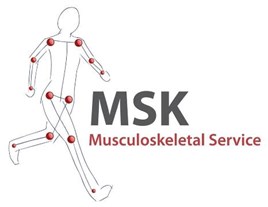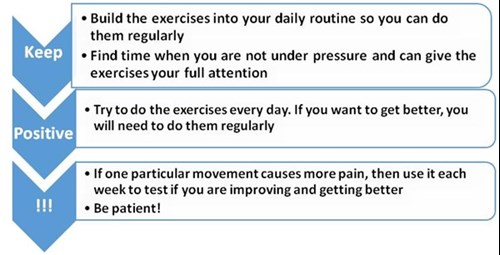
Exercises for stiff and painful shoulders
Exercise
Exercise has consistently been shown to improve symptoms associated with a painful shoulder, however it is important to remember that there is no magic recipe for what exercises you should perform.
No matter what the exercise is, the key to success and get the most out of your exercises is to:

You may find that these exercises slightly increase your symptoms initially. However you should find that the exercises themselves become easier to do and that you begin to move your shoulder more easily.
A rehabilitation programme starts with easier exercises and then needs to be progressed until you are able to do the activities you need to do with less pain, so don’t give up too early!
These exercises can take up around 12 weeks for you to notice a great improvement. If your shoulder does not improve over 12 weeks, or gets worse despite the exercises, then please contact your health professional.
Click HERE for a printable version of this section.
How much should I push my excercises?
Pain during your exercise
Aim to keep your pain under 5/10 during exercise. If your pain is over this, then you can modify the exercises by either; reducing the amount of movement during an exercise, reducing the number of repetitions, reducing the weights, reducing your speed or increasing how long you rest between sets.

Pain after Exercise
Your pain or other symptoms should return to your pre exercise baseline within 30 minutes of exercising. You should not feel an increase in your pain or stiffness the next morning. Although, sometimes it is normal to feel some muscle soreness from doing exercise that you have not been used to.
General excercise
The recommended levels of physical activity for adults is 150 minutes of moderate intensity exercise every week (30 minutes, 5 days out of 7). Research has shown that general aerobic exercise can be an effective way of keeping us healthy by reducing the risk of developing diabetes, heart disease, cancers and mental health problems.
We also know that aerobic exercise keeps our joints and tendons healthy, and can actually help with your shoulder pain.
You might think there is no way you could exercise when you are sore however there are ways around this. For instance if your shoulder is sore and you are limited in what shoulder exercises you can do, then exercise a different part of your body. For example go for a 30 minute walk or cycle or perform some leg strengthening exercises such as squats or step ups. There is even evidence to show that exercising your unaffected side can help to reduce pain in your painful side.
Click HERE for a printable version of this section.
Section 2: exercises for stiff and painful shoulders
The main aim of exercise in the treatment of a painful and stiff shoulder is to reduce pain and improve the range of motion. The exercises below are examples of how you can achieve this. The exercise are split into 3 levels of difficulty.
You may find that these exercises slightly increase your symptoms initially. However you should find that the exercises themselves will become easier to do.
If the exercises do cause some discomfort then taking prescribed medication from your GP or pharmacist may help you to continue to exercise.
There is no recipe for what exercises you should do for a stiff and painful shoulder so feel free to try out the examples and find the ones that you feel help you the most. The exercises have been split up into active movement exercises (Level 1), strengthening exercises (Level 2) and capsular stretches (Level 3).
Level 1
You may find that if you are in the painful stage of a frozen shoulder or are having a flare up of osteoarthritis these exercises may be helpful to get your painful shoulder moving with support.
Exercise 1: Pendular Exercises
In standing lean forward and rest your arm that is not sore on the back of a chair or kitchen work-top. Keep the sore straight and let it hang by your side. Swing the sore arm forwards and backwards for 15 repetitions, then side to side for 15 repetitions and then draw circles in a clockwise and anti-clockwise (both 15 repetitions).
To start with do 1 set of 15 repetitions and as you become fitter and stronger do 3 sets of 15 repetitions.
Exercise 2: Assisted Lateral Rotation
To do this exercise lie on your back. Have your elbows bent to 90 degrees and tuck your elbows in at the side of your body. Hold a walking stick or a broom in both hands and use it to push the painful arm out to the side keeping your elbow tucked in at the side.
To start with do 1 set of 15 repetitions 3 times per day and as you become fitter and stronger do 3 sets of 15 repetitions 3 times per day.
Exercise 3: Assisted Abduction
In standing have both arms straight and by your side holding onto a stick (a broom or mop handle will do). Use your arm that is not painful to push your painful arm out to the side. Keep your arm straight at all times and your shoulder relaxed.
To start with do 1 set of 15 repetitions 3 times per day and as you become fitter and stronger do 3 sets of 15 repetitions 3 times per day.
Exercise 4: Assisted Medial Rotation
In standing place your painful arm behind your back. Drape a rolled up towel over the shoulder that is not sore. Hold the towel in both hands. Use the arm that is not sore to pull the sore arm up your back.
Hold the stretch for 20 seconds and repeat 5 times.
Level 2
If your pain is under control and your main issue is stiffness or if you feel no benefit from the exercises in level 1 then these exercises may be helpful.
These exercises has been shown to be an effective way of increasing movement in the shoulder as well as improving strength. This type of exercise can cause some discomfort initially, however this is a normal reaction and should settle down.
Exercise 1: Assisted Flexion
To do this exercise lie on your back holding onto a walking stick in both hands. Keep both arms straight lift both arms up to the ceiling and move backwards towards your head or as far as pain allows.
To start with do 1 set of 15 repetitions 3 times per day and as you become fitter and stronger do 3 sets of 15 repetitions 3 times per day.
Exercise 2 : Lateral Rotation
To do this exercise lie on your back. Put both hands behind your head. Try and keep your shoulders relaxed. Gently move your arms apart and lower towards the bed. Initially hold for 5 seconds but slowly increase time gradually when you feel able to do so. Then slowly return back to the starting position keeping your hands behind your head.
To start with do 1 set of 15 repetitions and as you become fitter and stronger do 3 sets of 15 repetitions.
Exercise 3: Scapular Setting
You can do this exercise in either sitting or standing. Have your arms by your side with your palms facing forwards. Pull your shoulders backwards and squeeze your shoulder blades together. Try not to raise your shoulder up during this motion. Initially hold for 5 seconds, but slowly increase time gradually when you feel able to do so, then slowly release.
To start with do 1 set of 15 repetitions and as you become fitter and stronger do 3 sets of 15 repetitions.
Level 3
If your pain is under control and your main issue is stiffness at the limits of your movements, or if you feel the exercises in level 2 cause too much discomfort these exercises may be helpful. These exercises are types of stretches and in order for them to be effective they need to be performed every day and regularly, such as 3 times a day.
Exercise 1: Posterior Capsule Stretch/Crossbody Stretch
To do this exercise bring your painful arm across your body at chest height and use your other arm to the pull the sore arm further until you feel a pulling sensation at the back of the shoulder or arm.
Hold the stretch for 20 seconds and repeat 5 times.
Exercise 2: Anterior Shoulder Stretch/Doorway Stretch
To do this exercise stand facing a wall or door. Place the palm of your sore arm against the wall. Bend your arm to 90 degrees. Turn your body away from your arm. You will feel a stretch or pulling sensation at the front of your shoulder. Don’t worry if you cannot go as far as the video shows.
Hold for 20 seconds and repeat 5 times
Click HERE for a printable version of this section and additional exercise content.